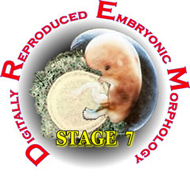Stage 7 embryos are in the presomite period and have a well defined embryonic disc with a greatest length between 0.3 and 0.7 mm. The embryonic disc is symmetrical and slightly convex in the plane of its longitudinal axis. The age of stage 7 embryos was initially believed to be about 16 days postfertilization, however, more recently, O'Rahilly and Müller (2001) have reassigned the ages of the Carnegie stages and have placed stage 7 at ca. 18 - 21 days. The stage is characterized by the appearance of the notochordal process and the gastrulation (primitive) node.
The stage is represented in the DREM databases by Carnegie embryo #7802 which has been given a grade of excellent. This specimen has a few of the characteristics of stage 8 embryos and is therefore considered to be an advanced stage 7 embryo. Heuser, Rock & Hertig (1945) estimated the age of this embryo to be 16½ days postovulation. It measures 0.42 mm in length, 0.35 mm in maximum width, and about 0.05 mm in maximum thickness.
This
specimen was collected and
prepared for microscopic examination in 1940. It was fixed in
70% alcohol and then in Bouin's fluid, embedded in celloidin/paraffin,
and serially sectioned transverse to the longitudinal axis at
6 microns. The sections were mounted on glass slides and stained
with hematoxylin and eosin. The 100 sections through
the embryonic disc and closely adjacent tissue are located on
slides 41 to 46. Structures are labeled
on every section image.
The
morphology of this embryo is well documented in
the literature.
There are photographs of the implantation site and graphic
reconstructions of the specimen. A drawing
through the median plane showing the right half of the
embryo was made from a model by Mr. J.F. Didusch in 1944.
We have generated a digital reconstruction of the median longitudinal
section corresponding to this drawing.
The
sections have been digitally restored and labeled, and can be
viewed at three magnifications. Several 3D
reconstructions
have been produced from the aligned sections. Labeled and unlabeled animations
of the 3D reconstructions together with flythrough
animations
of the aligned sections are also included on the disk. All
of the original section images are available as individual
.jpg files or as zip files for
anyone who wishes to use them for other reconstructions, research
or presentations, .
Instructions
for using the disks can be found by going to the
Instructions section from the opening screen.


